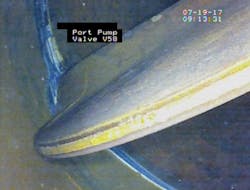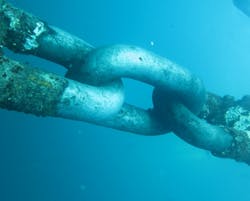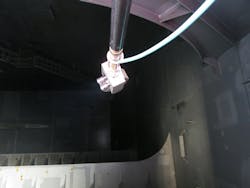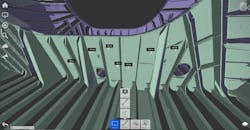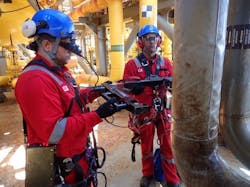Inspection advances improving integrity, service life of floating platforms
Danny Constantinis, EM&I Group
Floating platforms are increasing in number and complexity, particularly in deepwater environments. However, operating these assets is also becoming more of a challenge due to the different production requirements and evolving marine standards.
Early units were designed for a five-year drydocking cycle, but this has proven to be operationally untenable and in fact unnecessary. With newer units the target can be 25 years or more of uninterrupted service, and operators and owners have developed integrity, inspection and maintenance strategies to enable safe and economic operations for extended periods.
In this lower oil price era, the increased focus on cost reduction, without compromising safety, has led the industry to adopt radically new ways of operating using robotic and digitization methods to reduce human intervention for routine or hazardous tasks.
Co-operation and consensus between industry experts is the key to this process and the establishment of common standards, particularly for safety. Reducing the need for divers and weather-dependent activities, and for personnel working in hazardous areas - at height or in confined spaces - have been the main drivers. The various initiatives have helped cut costs by (50%) and Personnel Onboard (POB) by 70%, with improved efficiency. That is due in large part to the fact that the methods developed are implemented while the offshore assets are on station, on hire, and in operation, so avoiding out-of-service, shutdown costs and penalties.
Industry organizations such as HITS (Hull Inspection Techniques and Strategy) have brought together individuals from operators, classification societies, service providers, and academic institutions to address challenges such as diver-less hull inspection and maintenance, robotic inspection of tanks, and minimizing tank cleaning needs.
The rapid growth of the floating gas sector has introduced different challenges. For example, the proximity of FSRUs to population centers raises potential safety and environmental hazards that are different to those facing assets many miles from land. This has become a growing preoccupation for the industry and was the theme of the FPSO Forum in Singapore earlier this year. One outcome was the formation of the FLOGAS (Floating Gas) joint industry project (JIP), the main aim being to identify and foster solutions to integrity issues facing the nearshore vessels.
The oil and gas industry has made strides in formulating strategies for inspection and repair of pressure systems and electrical equipment. Adapting technology developed by other sectors such as medical, civil, nuclear and even forestry, has allowed the industry to fasttrack solutions to a Technical and Business Ready stage. So, what has been achieved to date?
Diver-less inspections of hull and sea valves, using multi-purpose Integrity Class ROVs, are now proven and commercially available. Diver-less repairs of valves, caissons and hull shell plating is also established. One key factor has been the ability to deploy a variety of tools on the ROV such as cavitation blasters to clean underwater components, avoiding the damage caused to coatings by mechanical cleaning tools.
Other advances include Integrity Class ROVs equipped with cavitation cleaning, calipers and laser chain angle measurement tools. For the tight spaces around the turret or fairleads specialized remote cameras can be deployed from the deck or turret to inspect confined areas around chain stoppers and fairleads. Another development set to be unveiled in 2020 is the use of chain ‘walkers’, designed with 3,000-m (9,842-ft) water depth capability, to inspect and measure mooring system status via photogrammetry and optical sensors.
Conventional cathodic protection is performed by sacrificial anodes or impressed current systems, both of which require diver intervention to maintain their integrity over the life cycle of the asset. However, a new class-approved solution is due to be installed on an FPSO in the North Sea which employs a retractable anode system. This can be fitted to new assets or retrofitted to existing ones without affecting normal operations. The anode position under the hull keeps it safe from mechanical damage but allows it to be withdrawn for inspection, cleaning and/or replacement as required.
Remote inspection of confined spaces is evolving rapidly with robotic camera systems deployed for visual inspection of tanks to class equivalent standards. A major recent breakthrough is the capability to measure thickness remotely using synchronous laser technology, as trialled on an operational FPSO offshore Equatorial Guinea. The technique is now undergoing refinement to apply laser point cloud data that will directly inform finite element analysis models; the significance is that the hull structure can be structurally assessed and monitored throughout its life and a digital twin developed that can be regularly updated though remotely obtained laser data.
Numerous Ex components on FPSOs must be ‘risk-ranked’ and inspected periodically. Some require a ‘detailed’ inspection which means isolating the systems and taking apart the components for inspection and subsequent reassembly. But this is costly and disrupts production. A new strategy has been developed that involves an adaptation of medical techniques to inspect the Ex components non-intrusively. Validation trials have been staged over the past two years, and the first commercial application should follow during the fall.
A major preoccupation for offshore asset owners, in terms of pressure system integrity is corrosion under insulation (CUI). One new technique involves the use of thermography to screen for water ingress under insulation in key risk areas such as field welds where the probability of poor-quality coatings is high. These are then scanned with real-time radiography units that have been adapted to provide qualitative data and fast screening of areas exhibiting evidence of CUI that are subsequently inspected using pulsed X-Ray techniques. Alternatively, the insulation can be removed and the CUI rectified.
Internal anomalies are only found in around 5% of periodic inspections, so there is clearly room for improvement. A statistical analysis program developed with a university in London has reduced the workscope of this process by around 50% while providing a high and quantified level of assurance.
Long-term partnerships between operators, contractors, and service groups can help realize the full benefits of emerging inspection technologies on floating assets. Familiarization with operators’ assets and ways of working makes it easier for service companies to introduce and efficiently deploy their systems on these assets, while at the same time gaining better understanding of the operators’ priorities, working with them to seek solutions. The construction industry adopted this approach in the 1980s to foster co-operation rather than conflict, and it worked well. •
